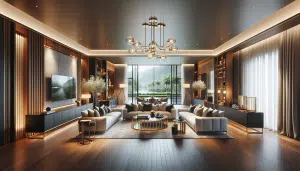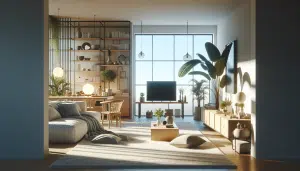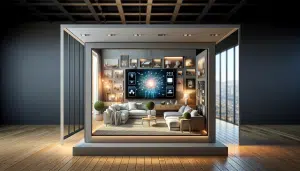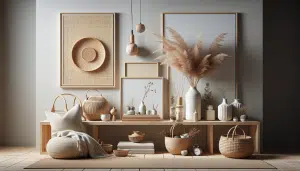Design Trends That Make Your Living Space Stand Out
Lily Carter October 14, 2025
Curious how interior design trends can transform your home lifestyle? Explore the latest ideas that blend comfort, creative decor, and sustainability, helping you create a unique living space that reflects personal taste without breaking the bank.
Embracing Sustainable Style in Home Decor
Sustainable home decor makes a big impact on both your living space and lifestyle. Choosing eco-friendly materials like bamboo, recycled glass, or reclaimed wood adds character and helps contribute to environmental well-being. Designers and homeowners increasingly look for ways to bring nature inside, using indoor plants, natural fibers, and earthy color palettes. These options aren’t just about aesthetics—they encourage healthy habits and foster a deeper connection to your environment, creating a welcoming atmosphere for guests and family alike.
Modern home trends focus on minimizing waste and integrating items that can be repurposed or recycled. Upcycled furniture and DIY decor projects offer creative outlets while promoting resourcefulness. Many people find inspiration from online communities that showcase how simple changes—like swapping single-use plastic for glass jars or sourcing second-hand finds—can revitalize an entire room. This movement supports individualized design, letting your home tell a one-of-a-kind story. Blending sustainability with style isn’t only trendy—it’s practical.
Adopting sustainable trends can even influence your lifestyle beyond interior decor. Investing in energy-efficient lighting or smart home technologies lowers utility costs over time. Thoughtfully chosen decor creates a sense of purpose in everyday routines, from morning coffee by a sunlit window to winding down with natural scents. Research suggests that sustainability at home supports mental well-being and mindfulness, making your living space an authentic retreat from daily stress.
Open-Plan Living and Flexible Layouts
Open-plan living is a trend that continues to shape modern homes. Removing or minimizing walls between the kitchen, living, and dining areas creates a sense of spaciousness and fosters social connection. This layout provides more light throughout your home, enhances usability, and makes entertaining easier. Families and roommates alike enjoy the casual, adaptable nature of open spaces, with fluid boundaries supporting both work and relaxation.
Flexible furniture and multi-functional zones are valuable in maximizing square footage. Pieces like modular sofas, nesting tables, or movable partitions accommodate changing needs throughout the day. For example, a dining table might serve as both a work desk and a family gathering spot. Innovations in furniture design mean that even small spaces can feel open and uncluttered when layouts are thoughtfully chosen. The result is a home that evolves with you, not the other way around.
Open-plan design isn’t just about removing barriers—it’s about strategic organization. Incorporating storage solutions like built-in shelves or under-bench compartments keeps the visual space tidy. Natural lighting from large windows or skylights amplifies the effect, infusing rooms with energy and positivity. Homeowners consistently cite the sense of freedom, increased interaction, and improved wellness as leading reasons to gravitate toward open concepts in their living areas.
Biophilic Design and Bringing Nature Indoors
Biophilic design is one of the most compelling trends redefining home environments. Rooted in the idea that humans thrive with regular access to nature, this approach introduces natural light, water elements, and organic shapes into living spaces. Indoor gardens, green walls, and potted plants come together to create a peaceful oasis in even the busiest households. The presence of foliage has been shown to reduce stress, boost mood, and enhance air quality.
Strategic use of biophilic elements can involve something as simple as a window seat with a view of the outdoors or as elaborate as an indoor atrium. Materials such as rattan, stone, and wool echo natural textures, providing tactile and visual comfort. Water features—like tabletop fountains—promote relaxation, while earthy colors remind us of campfires or forest walks. This connection to the outdoors nurtures creativity and focus—qualities highly valued in today’s lifestyle and entertainment-driven interiors.
Research highlights that biophilic design isn’t just a passing fad. Schools, offices, and healthcare facilities now integrate these concepts to support productivity and well-being. For home decor, the focus shifts to healthy indoor environments and sustainable routines. Whether it’s a minimal greenery display or a full-fledged sunroom, reconnecting with nature nurtures the mind and cultivates a sense of sanctuary, helping your home feel unique and alive.
Personalizing With Bold Color and Artistic Expression
Color is back in full force. Today’s designers encourage using bold accent walls, statement furniture, and playful color palettes to infuse personality into living spaces. Rather than sticking to neutral tones, more homeowners choose vibrant hues—deep blues, rich greens, and fiery reds—to reflect individuality. The result is a fresh, energized room that stands out and inspires conversation.
Beyond paint and upholstery, personal expression finds its way through art, textiles, and curious decor pieces. Displaying original paintings, handmade ceramics, or quirky vintage finds turns any room into a personal gallery. Layering various textures—from woven rugs to velvet cushions—adds warmth and dimension, inviting visitors to look closer and discover hidden details. This artistic approach celebrates your identity and passions, freeing you from design rules and encouraging experimentation.
The psychology of color plays an important role in mood and energy. For example, yellows evoke joy, while emerald greens foster tranquility. Strategic accent choices can lift spirits and motivate activity—even the smallest pop of color can create excitement. Experts suggest rotating art and accessories for a quick seasonal refresh, ensuring your home decor always feels up-to-date and authentic.
Smart Technology Integration for Modern Living
Technology has revolutionized home environments, creating smarter, more interconnected living spaces. Now, entertainment, comfort, and security can be managed seamlessly with voice assistants, app-controlled lighting, or automated window blinds. Integrated smart home systems allow you to tailor ambiance and function to suit daily routines. Changing lighting with a simple command or adjusting climate zones improves comfort and streamlines lifestyle choices.
Smart devices aren’t just gadgets—they’re tools for personalization and efficiency. Many choose products that automate tasks, like robotic vacuum cleaners or refrigerators that track grocery needs. Security enhancements include video doorbells and smart locks, providing peace of mind. These technologies can often be updated remotely, ensuring homes keep pace with rapid innovation in entertainment systems and interactive streaming experiences. Families and singles alike appreciate the convenience and adaptability offered by connected solutions.
Accessible smart technology enables more inclusive living, making controls easier for those with mobility challenges. Flexible setups mean any room, from kitchens to home offices, benefits from improvements in lighting, sound, and connectivity. Expert guides recommend planning technology around lifestyle needs—prioritizing reliable internet, strategic outlet placement, and user-friendly interfaces. With these smart tools, your home remains both sophisticated and highly functional, ready for anything the day brings.
Multifunctional Rooms for Everyday Flexibility
Multifunctional rooms redefine how we experience home living. Gone are the days when each space served a rigid, single purpose. Contemporary design trends embrace fluidity—guest bedrooms double as home offices, dining areas convert to creative studios, and living rooms host movie nights and yoga sessions. This versatility meets the needs of evolving lifestyles, especially with the rise of remote work and flexible schedules.
Furniture and layouts support this adaptable approach. Fold-down desks, Murphy beds, and expandable tables are now mainstays in urban apartments and suburban homes. These options optimize square footage, making even snug spaces feel accommodating. Invisible storage solutions keep clutter at bay, while foldable partitions or curtains allow quick transitions between relaxation and productivity. The result: homes that grow with their occupants.
Experts suggest investing in quality basics—neutral sofas, sturdy shelving, and comfortable rugs—that anchor a space regardless of how it’s used. Layering in mobile pieces or stackable seating increases possibilities for gatherings or spontaneous projects. This approach not only maximizes efficiency, it reveals how design and entertainment seamlessly intertwine in day-to-day living, making every room an opportunity for creativity and comfort.
References
1. Sustainable Furnishings Council. (n.d.). Eco-Friendly Home Design. Retrieved from https://www.sustainablefurnishings.org/eco-friendly-home-design
2. Interior Design Society. (n.d.). The Benefits of Open-Plan Living. Retrieved from https://www.interiordesignsociety.org/Articles/open-plan-living
3. Terrapin Bright Green. (2014). The Economics of Biophilia. Retrieved from https://www.terrapinbrightgreen.com/reports/the-economics-of-biophilia/
4. American Psychological Association. (n.d.). Color and Psychological Functioning. Retrieved from https://www.apa.org/monitor/2011/03/colors
5. Consumer Technology Association. (n.d.). Smart Home Trends. Retrieved from https://www.cta.tech/news/research-trends/research/2022/smart-homes-growing-in-popularity
6. National Association of Home Builders. (n.d.). Creating Flexible Living Spaces. Retrieved from https://www.nahb.org/blog/flexible-living-spaces







